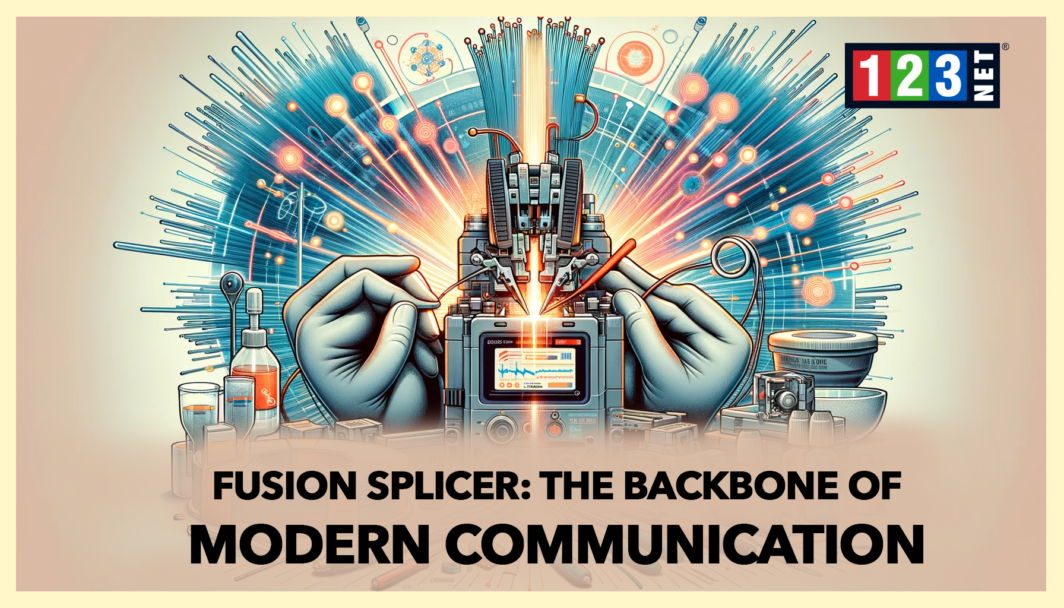
Introduction
In the telecommunications sector, the robustness and performance of fiber optic networks stand as critical elements. Central to these networks is the process of fusion splicing, which relies heavily on an essential tool: the fusion splicer. This device is instrumental in merging two fiber optic cables, creating a singular optical pathway that ensures uninterrupted data flow. Fusion splicers are not just about connecting cables; their role is crucial in reducing signal degradation and boosting network efficiency. This piece investigates the fusion splicer in depth, covering how it works, the different varieties available, and the top models currently dominating the market. Through fusion splicing, these splicers help maintain the high standards required for data transmission in today’s fast-paced. They digitally connected world, making them indispensable in the telecommunications industry.
What is a Fusion Splicer?
A fusion splicer stands as a specialized tool crafted for the purpose of joining two optical fibers end-to-end using heat. This technique, known as fusion splicing, is pivotal in the construction and upkeep of fiber optic networks. It ensures that the fibers are seamlessly combining to form a single, strand, which is crucial for maintaining low splice loss and high signal fidelity across the network. Fusion splicers come in two primary categories: core alignment and cladding alignment. Each tailored to meet specific requirements of fiber splicing.
Core alignment fusion splicers utilize advanced image processing technology to match the cores of the optical fibers precisely. This method is especially beneficial in scenarios demanding the utmost accuracy and minimal splice loss, making it suitable for high-speed, high-capacity telecommunications applications. These splicers are favored for their precision, though they come at a higher cost due to the complexity of the technology involved.
Conversely, cladding alignment fusion splicers align the fibers based on their outer diameter. This approach is generally more economical and is sufficient for connections where absolute precision is not critical. It offers a balance between performance and cost, making it a viable option for a wide range of applications.
Additionally, ribbon splicers represent a significant innovation in the field, capable of splicing multiple fibers at once. This feature drastically reduces the time and labor required to deploy extensive fiber optic networks. It is providing a substantial efficiency boost for large-scale operations.
In sum, fusion splicers are indispensable tools in the realm of telecommunications, with each type serving distinct splicing needs. From high-precision core alignment splicers to cost-effective cladding alignment and time-saving ribbon splicers, these devices ensure the integrity and efficiency of fiber optic networks. They also are supporting the seamless flow of digital communication across the globe.
How Fusion Splicers Work
Fusion splicing is a meticulous process that plays a vital role in the construction and maintenance of fiber optic networks. It starts with preparing the fiber ends that will be joining together. This preparation process involves stripping away the protective coating from the fiber, meticulously cleaning the exposed fiber to remove any contaminants, and cleaving the fiber to ensure the ends are perfectly flat and ready for fusion. Following preparation, the fusion splicer takes over, aligning the fiber ends in preparation for splicing. The alignment can be done, basing on the core or the cladding, depending on the type of splicer that they are using.
Core alignment splicers utilize sophisticated image processing technologies to align the fiber cores with precision. This method is crucial for applications demanding high accuracy, as it significantly reduces splice loss, ensuring optimal signal transmission. On the other hand, cladding alignment splicers align the fibers based on the outer cladding. This method is more cost-effective and sufficiently precise for many applications where the highest level of precision is not necessary.
Once alignment is achieved, the splicer employs an electric arc to heat and melt the ends of the fibers. It is fusing them together to create a single, continuous fiber strand. This fusion process is critical for maintaining signal integrity and minimizing loss at the splice point.
Modern fusion splicers have automated the entire splicing cycle—from the initial preparation of the fiber ends to the final fusion. This automation greatly enhances the efficiency and consistency of the splicing process. This is ensuring high-quality connections that are essential for the reliable performance of fiber optic networks. The development of these advanced splicing technologies underscores the importance of precision and efficiency in the rapidly evolving telecommunications industry, where the demand for high-speed, high-capacity connections continues to grow.
Top Fusion Splicers on the Market
Fujikura 90S+ Fusion Splicer: Renowned for its precision and reliability, the Fujikura 90S+ stands out with its core-to-core alignment technology. For its automated fiber splicing features, and robust design. It boasts a fast splicing cycle, advanced image processing for accurate fiber alignment, and a user-friendly interface.
Fujikura 88S+ Fusion Splicer: Similar to its counterpart, the 88S+ offers exceptional performance with core alignment technology, fast splicing and heating times, and automated features that streamline the splicing process. Its durability and ease of use make it ideal for field applications.
Comway C10S Fusion Splicer: The Comway C10S is a versatile splicer capable of handling various fiber types. Also including those used in 5G installations. It features precise core alignment, low power consumption, and a rugged design suited for challenging environments.
Fujikura 41S+ Fusion Splicer: This model is designed for efficiency and ease of use, featuring Bluetooth connectivity, a touch panel for simple operation, and a multifunctional carrying case. It’s an excellent choice for technicians looking for a reliable cladding alignment splicer.
Sumitomo Type-82C+ Fusion Splicer: Known for its ultra-fast splicing and heating capabilities, the Type-82C+ is a core alignment splicer that excels in speed without compromising on accuracy or reliability. Its compact and rugged design makes it suitable for field use.
FiTeL S179A Fusion Splicer: The S179A is celebrated for its high-speed splicing, portability, and state-of-the-art communication methods. It’s a core alignment splicer that delivers fast and reliable splicing, ideal for data centers and long-haul operations.
Choosing the Right Fusion Splicer
Choosing the right fusion splicer is a critical decision that hinges on various factors, key among them being the type of optical fibers to be spliced, the precision required for the splicing operation, and the conditions under which splicing will occur. For projects where high accuracy is paramount and splice loss is small, core alignment splicers are the go-to choice due to their sophisticated alignment capabilities. On the other hand, cladding alignment splicers present a more budget-friendly option for projects where the utmost precision is not as crucial. It makes them suitable for a broader range of applications.
Additionally, the splicer’s build quality and user-friendliness are essential considerations. Features that enhance the splicing process, such as automated fiber alignment, fast splicing cycles, and intuitive interfaces, can significantly impact the efficiency and ease of the task. Maintenance and support tools integrated into the splicer can further streamline operations and extend the device’s lifespan.
Ultimately, the selection of a fusion splicer is tailoring to the specific requirements of the fiber optic network project at hand. Ensuring that the device’s capabilities align perfectly with the needs of the installation or maintenance work. This careful consideration ensures optimal performance and reliability of the fiber optic infrastructure.

Maintenance and Care for Fusion Splicers
Maintaining fusion splicers in prime condition is key to their longevity and the quality of splicing they produce. Regular maintenance tasks are critical for preventing contaminants from compromising splice integrity. Essential maintenance practices include thorough cleaning of the splicer’s crucial components, like V-grooves, mirrors, and electrodes, which play significant roles in the splicing process. Dirt or debris in these areas can lead to subpar splicing results.
In addition to physical cleaning, it’s important to keep the splicer’s software up to date. Manufacturers often release updates that enhance the device’s functionality or address known issues. Regular software updates ensure the splicer operates with the latest improvements and security patches. Calibrating the arc settings is another maintenance step that cannot be overlooked. Proper calibration ensures that the electric arc used to fuse fibers does so at an optimal intensity, crucial for achieving low splice loss and high-quality connections.
Proper handling and storage of the fusion splicer also contribute significantly to its durability and performance. Protective cases are essential for minimizing the risk of damage, especially when transporting the splicer between locations. Furthermore, shielding the device from harsh environmental conditions, such as extreme temperatures, moisture, and dust, helps in preserving its functionality and extending its service life. Adhering to these maintenance and care practices ensures that fusion splicers remain reliable tools for telecommunications infrastructure. It will be delivering optimal performance over their operational lifespan.
FAQs
- What is the average lifespan of a fusion splicer? A: The lifespan of a fusion splicer can vary widely depending on the model, usage, and maintenance. With proper care, a high-quality splicer can last over 10 years.
- How does temperature affect fusion splicing? A: Extreme temperatures can impact the splicing process, potentially affecting splice loss and the splicer’s performance. Most modern splicers have temperature compensation features to mitigate these effects.
- Can fusion splicers be used for all types of fiber optic cables? A: While most fusion splicers are versatile enough to handle various fiber types, including single-mode, multimode, and specialty fibers, it’s essential to check the splicer’s specifications to ensure compatibility with the fibers being used.
Fusion splicers are indispensable tools in the fiber optic network installation and maintenance toolkit, offering precision, efficiency, and reliability. Understanding the different types of splicers, how they work, and the top models available can help professionals make informed decisions. It is ensuring the integrity and performance of fiber optic networks.




